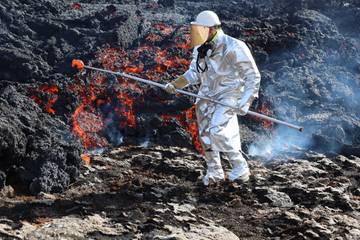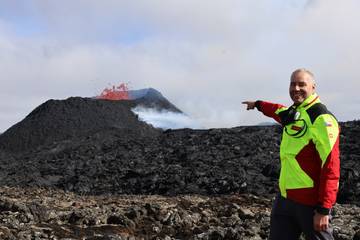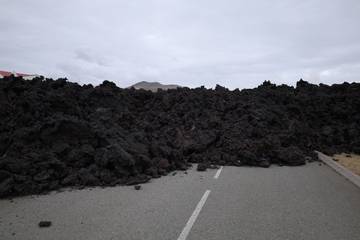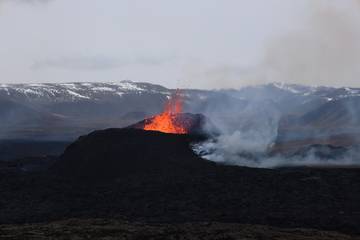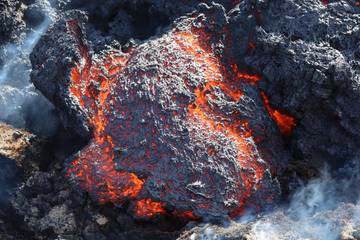Professor Lukáš Krmíček studies the active eruption threatening the city of Grindavík
Researchers have observed the first manifestations of the tipping point era of volcanic activity in Iceland on the Reykjanes Peninsula between 2021 and 2023 within the Fagradalsfjall volcanic system. However, there are four other systems in the area that have so far been inactive for hundreds of years or longer.
Dangerous Grindavík
Since autumn 2023, tectonic unrest associated with magma movement has been observed and the main volcanic activity has shifted to the Svartsengi system. A geothermal power plant of the same name is linked to this system, which supplies heat and electricity to the capital Reykjavík. It is also the location of the important fishing town of Grindavík, beneath which the bedrock was destroyed on 10 November 2023 by the rapid intrusion of an approximately 15 km long basaltic sill. This event, in which magma filled relatively shallow tectonic structures, determined the fate of the town and its immediate surroundings for many years to come.
A massive sinkhole formed across the whole of Grindavík. The city's inhabitants had to be evacuated and the fight for time began. Protective barriers were hastily built around the plant and the town. In November, the magma had not yet reached the surface and stopped at a depth of about 500 metres. A month later (18 December), a massive eruption had already occurred along a set of en-chelon fissures that formed about 4 km northeast of the town. The fissures followed the course of the November basaltic sill. The eruption subsided after three days, but magma began to rapidly recharge into the fractured bedrock. In less than a month, the darkest fears of Grindavík's residents were realized, and on Sunday, January 14, 2024, another eruption began, with one of the fissures occurring at the very northern edge of the development, outside the boundaries of the protective wall. The lava completely destroyed several houses. Fortunately, the eruption soon subsided, but the next one began less than a month later, on Thursday 8 February. Eruption stopped the following day, but the basaltic lava managed to disrupt both the road to Grindavík and the heating pipeline supplying heat to many households on the peninsula. Many of the town's residents have moved out completely, while others have returned after ordered evacuations and are determined to face an uncertain future.
Earthquakes, lava and a ban on entry
The latest eruption so far began north of Grindavík on 16 March and is still ongoing. The protective wall system has worked well and has so far managed to divert all lava flows heading towards Grindavík in a different direction. The whole area, which is threatened by earthquakes, volcanic gases and the lava itself, has been completely closed to the public until today. One of the few exceptions has been given to scientists involved in studying the current eruption. Among these experts is Lukáš Krmíček, professor at the Institute of Geotechnics, FAST BUT, who has just returned from a field trip to Iceland. "My main task was to collect liquid lava samples. A comprehensive petrological study will be carried out on them to help answer the key question: whether and in which aspects are the Fagradalsfjall and Svartsengi volcanic systems interconnected. This knowledge will help volcanologists to better predict the evolution of volcanic activity," explains Professor Krmíček.
He has been working in the field with colleagues from the Laboratory of Volcanology and Natural Hazards at the University of Iceland, building on a previous successful collaboration studying the Fagradalsfjall volcanic system. The stormy atmosphere on site is documented in the attached photographs.
Prof. RNDr. Lukáš Krmíček, Ph.D., in addition to teaching at the Institute of Geotechnics, Faculty of Civil Engineering, Brno University of Technology, is engaged in combined research on mineralogical, geochemical and physical-mechanical properties of igneous rocks. He studies volcanic activity all over the world, besides Iceland, e.g. Faroe Islands, Spitsbergen, Antarctica and Hawaii. He is a well-known popularizer of science and is currently preparing a book, The World of Volcanoes Up Close, aptly subtitled The Birth of a Volcano. The book is expected to be published by Albatros Media in June this year.
| Short link | https://www.fce.vutbr.cz/en/research/achievements/403 |
|---|---|
| Responsible person | Mgr. Almíra Pitronová |
| Published |
